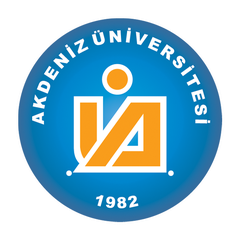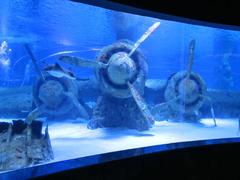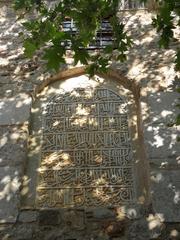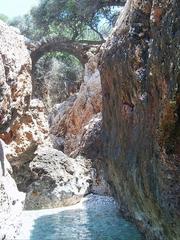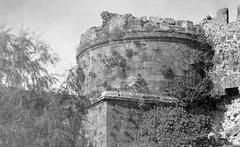Visiting Sura (Lycia), Antalya, Turkey: Complete Guide — Tickets, Hours, and Tips
Date: 14/06/2025
Introduction: Why Visit Sura (Lycia)?
Nestled in the heart of Antalya Province, southwestern Turkey, Sura (also spelled Soura) is an evocative ancient Lycian city offering a rare window into the region’s spiritual, cultural, and political life. Celebrated for its famed Temple of Apollo and the oracle that interpreted the movements of fish in a sacred spring, Sura was a vital religious center in the Lycian League—a federation whose proto-democratic system influenced later governance models.
Today, Sura is an atmospheric, largely unexcavated site surrounded by Mediterranean vistas and pine-forested slopes. Its ruins include the vestiges of the temple complex, impressive rock-cut tombs with Lycian inscriptions, city walls, and other remnants that reflect the region’s layered past, from the classical Lycian era through Hellenistic, Roman, and Byzantine periods. Sura’s tranquility and authenticity, along with its proximity to other major Lycian sites, make it a rewarding stop for history enthusiasts, hikers on the Lycian Way, and cultural explorers seeking a deeper understanding of ancient Anatolia.
This guide covers Sura’s historical significance, key archaeological features, directions and accessibility, visiting hours and ticket policies, practical tips, and nearby attractions—everything you need to plan your visit to one of Antalya’s hidden historical treasures.
For further planning, consult resources like Visit My Turkey, Antalya Tourist Information, and Archaeotravel.eu.
Contents
- Sura in the Lycian World: History and Spiritual Role
- Archaeological Highlights: What to See
- Visiting Sura: Hours, Tickets, and Access
- Tips for Travelers: Preparation, Facilities, and Safety
- Combining Sura with Nearby Historical Sites
- FAQ
- Useful Links and Further Reading
Sura in the Lycian World: History and Spiritual Role
Origins and Political Importance
Lycia, inhabited since the second millennium BCE, was home to a unique culture and language. Sura rose to prominence in the classical period as a member of the Lycian League—a confederation noted for its democratic structure (Wikipedia). Sura’s religious prestige, especially its oracle, granted it two votes in the League’s assembly, demonstrating political as well as spiritual influence (Visit My Turkey). Its location near Demre (ancient Myra), on the Mediterranean coast, facilitated maritime trade and connections with neighboring Lycian cities such as Xanthos, Patara, and Letoon.
The Oracle of Apollo
Sura’s fame rested on its oracle of Apollo, which was considered second only to those at Delphi and Didyma. Unique to Sura, the priests interpreted the will of Apollo by observing sacred fish in a spring—an unusual oracular method that drew pilgrims from across Lycia and beyond. Ancient accounts describe a temple complex and a rectangular pool where these rituals took place, with inscriptions documenting dedications and religious activities (Visit My Turkey).
Cultural and Religious Evolution
Sura’s architecture and inscriptions reflect successive Persian, Hellenistic, Roman, and Byzantine influences. Under Roman rule, infrastructure improvements and the oracle’s continued prominence affirmed the city’s status. During the Byzantine era, Christianity became dominant, and churches were built alongside the older pagan sanctuaries, illustrating a complex spiritual landscape (Archaeotravel.eu).
From the 13th century, Sura declined due to regional instability and changing settlement patterns, with limited occupation in Ottoman times.
Archaeological Highlights: What to See
Temple of Apollo and Sacred Spring
Remnants of the Temple of Apollo and the sacred spring are the site’s focal points. The pool associated with the fish oracle is still visible, along with scattered column drums and foundations that mark the temple’s location (THE BOOK OF LYCIA).
Rock-Cut Tombs and Funerary Art
Sura is notable for its rock-cut tombs, carved into limestone cliffs and adorned with intricate reliefs and bilingual inscriptions in Lycian and Greek. These tombs provide invaluable historical and linguistic insights and are among the best examples of Lycian funerary architecture (Visit My Turkey).
City Walls and Urban Remains
Defensive walls constructed of large polygonal stones, residential terraces, and the partial layout of the ancient city can be discerned among the overgrown ruins. The harmony between architecture and natural features, especially the use of the sacred spring and surrounding cliffs, is characteristic of Lycian city planning (The Book of Lycia).
Byzantine Churches
Several early Christian churches dot the site, indicating Sura’s continued religious importance through the Byzantine period. The coexistence of pagan and Christian ruins attests to the city’s evolving spiritual landscape.
Visiting Sura: Hours, Tickets, and Access
Location
Sura is located near the village of Çavdır (or Gürses), approximately 6 km from Demre (ancient Myra) in Antalya Province. The site sits on the southern slopes of the Taurus Mountains, overlooking the Mediterranean.
Directions and Getting There
- By Car: From Antalya, drive west along the D400 highway to Demre (about 140 km). From there, follow signs to Çavdır and Sura. Final access roads may be unpaved.
- By Bus: Intercity buses run from Antalya and Fethiye to Demre. From Demre, arrange a taxi or local minibus (dolmuş) to the site.
- On Foot: Sura is a stop on the Lycian Way hiking trail, accessible via scenic, moderately challenging walks (beatthetrail.com; brokenbootstravel.com).
Visiting Hours
- Sura is an open archaeological site, accessible year-round, 24 hours a day. For safety and the best experience, visit during daylight hours—typically between 8:00 AM and 6:00 PM.
Tickets and Fees
- As of June 2025, there is no entrance fee to visit Sura. The site is unsupervised and open to the public. Donations to local preservation efforts are appreciated.
Accessibility
- The terrain is rugged and uneven, with some steep and overgrown areas. The site is not wheelchair accessible and poses challenges for visitors with limited mobility. Sturdy footwear is essential.
Tips for Travelers: Preparation, Facilities, and Safety
- Facilities: There are no restrooms, cafés, or shops onsite. Bring water, snacks, and sun protection.
- Weather: Spring (April–June) and autumn (September–October) offer the most pleasant climate and lush scenery (theturkeytraveler.com). Summers can be very hot; visit in early morning or late afternoon.
- Local Services: The nearest amenities, including accommodations and restaurants, are in Demre.
- Guided Tours: Local guides in Demre offer tours that provide valuable historical context, transportation, and navigation.
- Safety: Carry out all rubbish, respect the ruins, and do not disturb archaeological features. Mobile signal is available but can be patchy—download maps in advance.
- Dress: Modest attire is appreciated, especially in rural areas. Basic Turkish greetings go a long way in local interactions.
Combining Sura with Nearby Historical Sites
Sura’s location makes it ideal for a multi-site Lycian adventure.
- Myra: Renowned for its rock-cut tombs and Roman theater, just 6 km from Sura.
- Andriake: Ancient harbor with impressive granaries and museum.
- Church of St. Nicholas: Important Christian pilgrimage site in Demre.
- Lycian Way: Sura is a highlight on this famous trekking route (chasingthedonkey.com).
For more on combining sites, see planetware.com.
FAQ
Q: What are Sura’s visiting hours?
A: The site is open year-round, 24/7, but visiting during daylight hours (8:00 AM–6:00 PM) is safest.
Q: Is there an entrance fee?
A: No, Sura is free to visit as of June 2025.
Q: How do I get to Sura from Antalya?
A: Drive or take a bus to Demre, then a taxi or dolmuş to Sura. Hikers can reach it via the Lycian Way.
Q: Are guided tours available?
A: Yes, local guides in Demre can be hired for tours and transport.
Q: Is Sura accessible for people with disabilities?
A: The site’s uneven terrain limits accessibility for visitors with mobility challenges.
Q: Are there facilities onsite?
A: No, bring all essentials with you. The nearest facilities are in Demre.
Useful Links and Further Reading
- Visit My Turkey - Sura
- Antalya Tourist Information
- Archaeotravel.eu - Lycia
- The Book of Lycia
- THE BOOK OF LYCIA (Academia.edu)
- Practical Guide to the Lycian Way
- Hiking the Lycian Way
- Map of Sura on Mapcarta
- Best Time to Visit Antalya
- Weather2Travel Antalya
- Exploring Myra
- Patara Guide
- Demre Travel Guide
Final Tips and Summary
Sura is a tranquil, lesser-known archaeological site that rewards independent travelers with its evocative ruins, natural beauty, and a sense of discovery. Its free and open access, combined with lack of modern development, ensures an authentic experience. For the best visit, plan ahead for logistics, bring necessary supplies, and consider hiring a local guide for deeper insight.
Combine your visit with other Lycian sites for a comprehensive journey through Antalya’s ancient heritage. Support conservation efforts by following responsible tourism practices and by respecting both the ruins and the landscape.
For ongoing updates, weather forecasts, and practical travel advice, download the Audiala app and consult the resources listed above.
Sources:
- Visit My Turkey - Sura
- Patara - Visit Turkey
- Letoon - Visit Turkey
- Practical Guide to Lycian Way
- Hiking the Lycian Way
- THE BOOK OF LYCIA (Academia.edu)
- Mapcarta – Sura
- Archaeotravel.eu - Lycia
- Antalya Tourist Information
- The Book of Lycia
- Best Time to Visit Antalya
- Weather2Travel Antalya
- Chasing the Donkey - Lycian Way
- Planetware - Antalya Attractions
